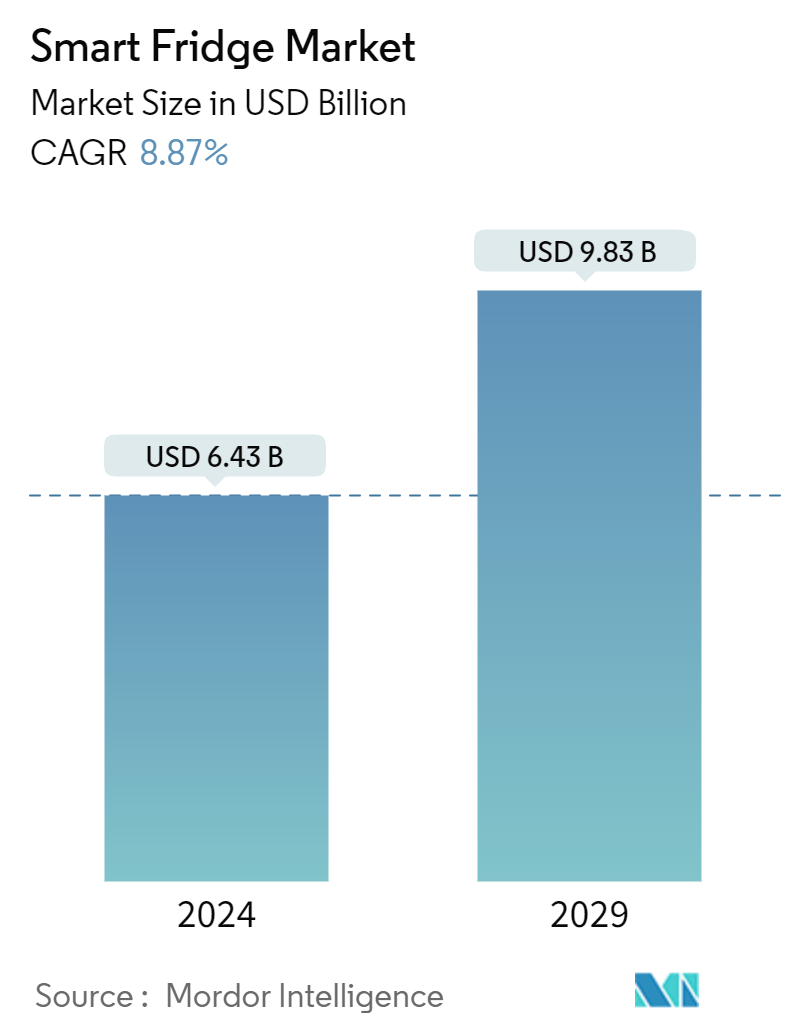Market Size of Smart Fridge Industry

| Study Period | 2020 - 2029 |
| Market Size (2024) | USD 6.43 Billion |
| Market Size (2029) | USD 9.83 Billion |
| CAGR (2024 - 2029) | 8.87 % |
| Fastest Growing Market | Asia Pacific |
| Largest Market | North America |
Major Players
*Disclaimer: Major Players sorted in no particular order |
Smart Fridge Market Analysis
The Smart Fridge Market size is estimated at USD 6.43 billion in 2024, and is expected to reach USD 9.83 billion by 2029, growing at a CAGR of 8.87% during the forecast period (2024-2029).
Technological advancements led to several improvements in home appliances, which led to the launch of the smart fridge. Smart fridges are integrated with advanced features like voice recognition, touch screens, internet, and Bluetooth connectivity that aim to provide convenience to consumers. Personal devices like cell phones and tablets can easily connect to smart fridges. Users can easily handle and regulate food storage in the refrigerator through wireless personal devices via software. Therefore, the rise in digitalization led to the growth of the smart fridge market.
During the initial stage of the COVID-19 pandemic, the market experienced losses due to a stoppage in manufacturing and distribution services due to supply chain disruptions. Later, due to lockdowns and the work-from-home culture, the demand for smart fridges increased. With the passing of the pandemic, the market is experiencing gradual growth according to seasonal demand fluctuations.
The rise in residential constructions and the emergence of green buildings led to a high demand for smart fridges. Also, lifestyle changes and tight schedules increased the requirement for a smart fridge.
Smart Fridge Industry Segmentation
A smart fridge is a kitchen appliance that is connected to the internet. Smart fridges can also be connected to personal devices so that the functions and temperature can be modified through smartphones via software. The smart fridge market is segmented by type, distribution channel, end user, and geography. By type, the market is segmented into side-by-side refrigerators, bottom freezer refrigerators, double-door refrigerators, single-door refrigerators, and French-door refrigerators. By distribution channel, the market is segmented into online stores and offline stores. By end user, the market is segmented into residential and commercial. By geography, the market is segmented into North America, Europe, Asia-Pacific, South America, and Middle East and Africa. The report offers the market sizes and forecasts for the smart fridge market in value (USD) for all the above segments.
| By Type | |
| Side-by-side Refrigerators | |
| Bottom Freezer Refrigerators | |
| Double Door Refrigerators | |
| Single Door Refrigerators | |
| French Door Refrigerators |
| By Distribution Channel | |
| Online Stores | |
| Offline Stores |
| By End User | |
| Residential | |
| Commercial |
| By Geography | |||||||
| |||||||
| |||||||
| |||||||
| |||||||
|
Smart Fridge Market Size Summary
The smart fridge market is poised for significant growth, driven by technological advancements and increasing digitalization. These fridges, equipped with features like voice recognition, touch screens, and connectivity options such as internet and Bluetooth, offer enhanced convenience and integration with personal devices. The market experienced initial setbacks during the COVID-19 pandemic due to supply chain disruptions, but demand surged as consumers adapted to lockdowns and remote work, leading to a gradual recovery. The rise in residential construction and the trend towards green buildings further fuel the demand for smart fridges, which are designed to integrate seamlessly into smart home ecosystems, optimizing energy efficiency and user experience.
In North America, the demand for smart fridges is particularly strong, driven by the increasing number of nuclear families and a high-income demographic willing to invest in premium appliances. These fridges offer features that enhance convenience and energy conservation, appealing to consumers' desire for advanced, efficient living solutions. The market is characterized by fragmentation, with major players like Electrolux Group, Haier Group Corporation, Whirlpool Corporation, Samsung Electronics Co. Ltd, and Panasonic Corporation leading through product innovation and strategic marketing. Recent developments, such as Samsung's launch of a feature-rich smart fridge in India and Haier's significant investment for expansion, highlight the competitive and dynamic nature of the market.
Smart Fridge Market Size - Table of Contents
-
1. MARKET INSIGHTS AND DYNAMICS
-
1.1 Market Overview
-
1.2 Market Drivers
-
1.2.1 Growth in the Tech-Savvy Millennial Population
-
1.2.2 Increasing Purchasing Power and Rising Disposable Incomes
-
-
1.3 Market Restraints
-
1.3.1 Risk of Malware Attacks
-
1.3.2 Higher Cost of Maintenance
-
1.3.2.1
-
-
1.3.3 Market Opportunities
-
1.3.3.1 Technological Advancements in Smart Fridges
-
-
-
1.4 Value Chain Analysis
-
1.5 Industry Attractiveness - Porter's Five Forces Analysis
-
1.5.1 Bargaining Power of Suppliers
-
1.5.2 Bargaining Power of Buyers
-
1.5.3 Threat of New Entrants
-
1.5.4 Threat of Substitutes
-
1.5.5 Intensity of Competitive Rivalry
-
-
1.6 Insights on Recent Developments in the Smart Fridge Market
-
1.7 Insights on Technological Innovations in the Industry
-
1.8 Impact of COVID-19 on the Market
-
-
2. MARKET SEGMENTATION
-
2.1 By Type
-
2.1.1 Side-by-side Refrigerators
-
2.1.2 Bottom Freezer Refrigerators
-
2.1.3 Double Door Refrigerators
-
2.1.4 Single Door Refrigerators
-
2.1.5 French Door Refrigerators
-
-
2.2 By Distribution Channel
-
2.2.1 Online Stores
-
2.2.2 Offline Stores
-
-
2.3 By End User
-
2.3.1 Residential
-
2.3.2 Commercial
-
-
2.4 By Geography
-
2.4.1 North America
-
2.4.1.1 United States
-
2.4.1.2 Canada
-
2.4.1.3 Mexico
-
2.4.1.4 Rest of North America
-
-
2.4.2 Europe
-
2.4.2.1 United Kingdom
-
2.4.2.2 Germany
-
2.4.2.3 Italy
-
2.4.2.4 Rest of Europe
-
-
2.4.3 Asia-Pacific
-
2.4.3.1 India
-
2.4.3.2 China
-
2.4.3.3 Japan
-
2.4.3.4 Australia
-
2.4.3.5 Rest of Asia-Pacific
-
-
2.4.4 South America
-
2.4.4.1 Brazil
-
2.4.4.2 Argentina
-
2.4.4.3 Rest of South America
-
-
2.4.5 Middle East and Africa
-
2.4.5.1 South Africa
-
2.4.5.2 UAE
-
2.4.5.3 Rest of Middle East and Africa
-
-
-
Smart Fridge Market Size FAQs
How big is the Smart Fridge Market?
The Smart Fridge Market size is expected to reach USD 6.43 billion in 2024 and grow at a CAGR of 8.87% to reach USD 9.83 billion by 2029.
What is the current Smart Fridge Market size?
In 2024, the Smart Fridge Market size is expected to reach USD 6.43 billion.

